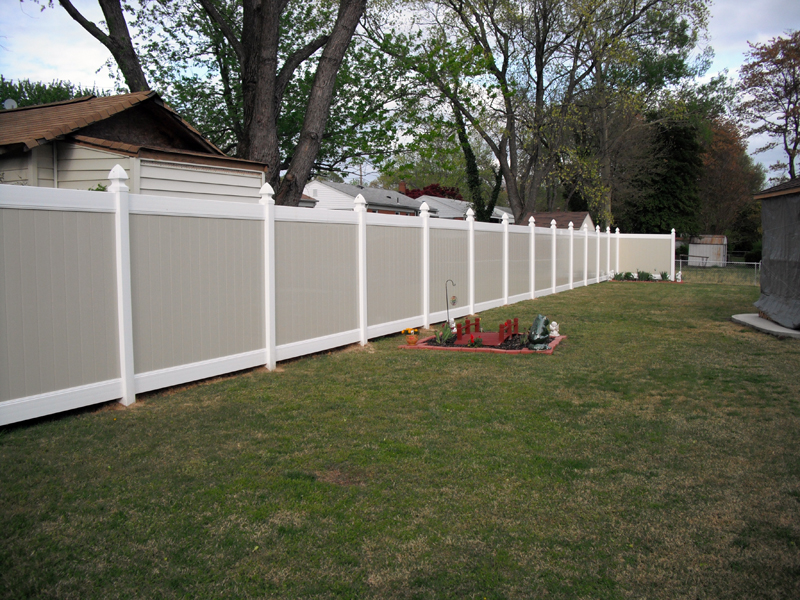When deciding whether a plastic fence is best for your project, you will want to consider cost, appearance, how easy it is to maintain, and how durable it is. You will also want to consider how long you will own the property that the vinyl fence will secure. To help you, we put together a few ideas on each factor for your consideration.
Plastic Fence History
Manufacturers introduced plastic fencing to the market in the 1980s as a quality, long-lasting substitute for wooden horse fencing, the only material available for such fencing at the time. Vinyl fences are often recommended for animal fences since animals cannot chew through it and it won't hurt them if they try to crash through it.
In the years since its introduction, vinyl has become one of several popular fencing options (the others being wood or chain link) for houses and other properties.
Plastic Fence Advantages
Appearance
You can buy plastic fencing that looks like wood so that you get the beauty of a wood appearance with the lasting characteristics of vinyl. You may have some limitations in color choice but there are many options from which to choose. You will also want to ask your supplier how your color choice will react to various weathering as some colors may fade. Today's manufacturers often treat vinyl fence modules with titanium dioxide, a substance akin to sunscreen for vinyl, that helps the product resist fading from exposure to the sun.
Installation
Plastic fencing comes in either interlocking panels or board-and-rail systems. The original fence installation is so simple that many consumers find it easy to install themselves instead of going to the expense of hiring a professional to do the job. In a board-and-rail system, for example, you merely slide the rails into posts and put the posts in the ground. You want to make sure when you install the fence that the posts are straight (vertical), in-line, and perfectly spaced. If you measure properly when you install your vinyl fence, you will find snapping the pieces together like playing with adult-sized Lego blocks.
Durability
Plastic fences last for decades and are five times stronger than wood. Unlike wood or chain link, vinyl is flexible and does not break unless it sustains a direct hit (for example, a kick from a horse, or a rock thrown by a lawnmower). Vinyl fences do not crack, rot, or splinter like wooden fences. Vinyl is impervious to weathering and to pests like termites, fungus, dry rot, and decay. Vinyl is fire resistant. Vinyl fences are so durable, most products carry a lifetime warranty. Vinyl fences are often used in seaside environments because exposure to salt water causes problems for chain link and wooden fences.
Temperatures/Wind
While vinyl is impervious to most weathering, there are a couple of weather-related exceptions to the rule to bear in mind. Extreme temperatures (100 degrees+) can cause vinyl to bend, expand or become brittle. High winds may cause sections of vinyl fencing to twist in the wind and prolonged exposure to gusty high winds may cause permanent damage. Algae, mold, and mildew may affect some types of vinyl so avoid placing vinyl fencing near water sprinkler systems.
Cleaning
The algae, mold and mildew are easy to remove if you catch and clean it early. You must remove it before the ugly green and black staining sets into the vinyl. Regular cleaning is a snap with a soft cloth, dish detergent and a water hose. For more stubborn stains, you may want to use Simple Green and a stainless steel pad.
Maintenance
Plastic costs very little to maintain. The rain can wash it for you or a rinse with your hose does the job. You will never have to paint, scrape, or seal a vinyl fence. Unlike chain link fencing, vinyl never rusts. Of course, even though vinyl is flexible, breaks sometimes happen. If it does, you will need to repair the entire section where the break occurred. And you may need a professional to do the repair if you do not want the expense of replacing the entire fence.
Cost
Vinyl fencing is more expensive than wood if you only look at the upfront costs. At first blush, depending on your budget and the size of the area you want to fence, vinyl may not seem to suit your purposes; however,vinyl easily out lasts wood in terms of maintenance and durability. Therefore, vinyl wins on cost over the long-term.
Environmentally safe
For consumers that wish to maintain a "green" profile, vinyl is prime for recycling when its life as a fence is over. Some makers of vinyl fencing even use recycled pop bottles to make vinyl fences. In most cases, today's manufactured vinyl fencing is non-toxic and not treated with harsh chemicals or preservatives like wood. We note, however, that removing stubborn or set-in algae, mold, or mildew may require harsh chemicals, like bleach, that are not environmentally friendly.
Aesthetics
Vinyl manufacturers often design vinyl fencing to look like wood and that works great from far away. If you plan to install vinyl fencing on an old vintage wood property or a ranch-style home, the aesthetics of vinyl fencing may jar your artist's eye. When viewed up close, the eyes are not deceived and it looks like plastic fencing.
Finally, do your homework
Make sure you know the warranties that come with the plastic fence you are considering for your project. Make sure that vinyl is the best choice for your fencing needs.
If you want to talk more about this topic, or anything else, please contact us. Make us your resource for all your questions about fencing.
Related Reading:


